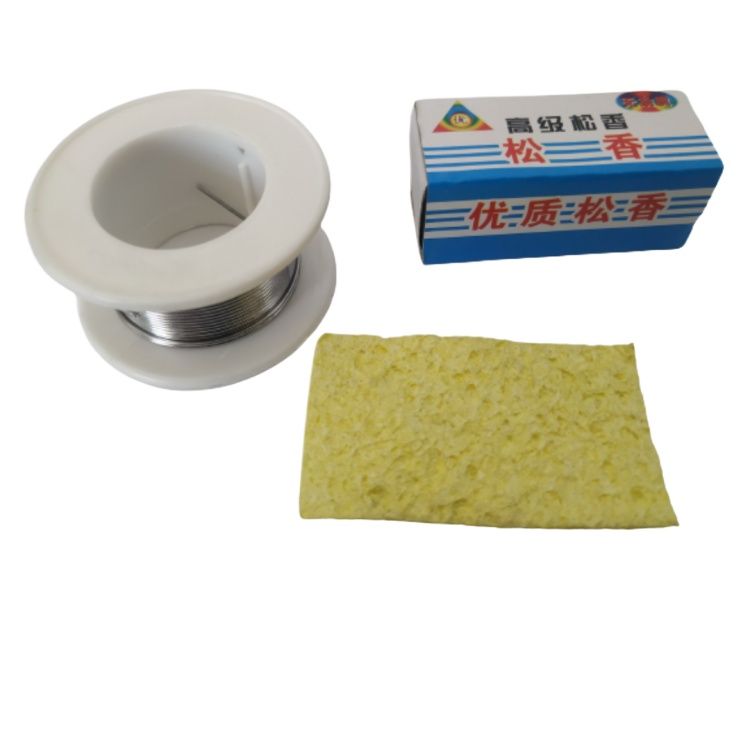 ### Soldering Wire and Flux Set Overview
### Soldering Wire and Flux Set Overview
A soldering wire and flux set is essential for anyone involved in electronics assembly or repair. Here’s a detailed overview:
#### Soldering Wire
1. **Type**: Core Wire with Flux (Rosin-core solder is common).
2. **Functionality**:
– **Electrical Connections**: Used to join electrical components together, ensuring good conductivity.
– **Melting Point**: Melts when heated by a soldering iron, allowing it to flow into joints.
3. **Specifications**:
– **Composition**: Typically made of a combination of tin (Sn) and lead (Pb) in various ratios (e.g., 60/40, 63/37) or lead-free (e.g., Sn/Cu, Sn/Ag/Cu).
– **Diameter**: Common diameters range from 0.5mm to 1.2mm, depending on the application.
– **Flux Core**: Contains a flux core to aid in the soldering process by cleaning and preventing oxidation.
4. **Features**:
– **Good Wetting**: Ensures strong and reliable joints.
– **Easy to Use**: Flows smoothly when melted, making it easy to work with.
– **Rosin Core**: Commonly used flux type that is suitable for most electronic applications.
### Flux
1. **Type**: Rosin, No-Clean, or Water-Soluble.
2. **Functionality**:
– **Cleaning Agent**: Removes oxidation from metal surfaces to ensure a clean and strong solder joint.
– **Improves Flow**: Helps solder flow and bond to the metals being joined.
3. **Specifications**:
– **Form**: Available in liquid, paste, or gel forms.
– **Activation**: Activated by heat during the soldering process.
– **Residue**: No-clean flux leaves minimal residue, while rosin and water-soluble fluxes may require cleaning.
4. **Features**:
– **Enhanced Soldering**: Improves the quality and reliability of solder joints.
– **Variety of Forms**: Available in different forms for various applications and preferences.
– **Residue Options**: Choose based on the necessity to clean after soldering.
### Typical Uses:
– **Electronics Assembly**: Essential for assembling printed circuit boards (PCBs) and electronic components.
– **Repairs**: Used in repairing broken or damaged electronic connections.
– **Prototyping**: Ideal for creating prototypes and custom circuits.
### Key Benefits:
– **Strong Joints**: Ensures reliable and conductive connections.
– **Versatility**: Suitable for a wide range of soldering applications in electronics.
– **Improved Work Quality**: Flux enhances solder flow and bond strength.
### How to Use:
#### Soldering Wire:
1. **Preparation**: Clean the surfaces to be soldered.
2. **Heat**: Heat the joint with a soldering iron.
3. **Apply Solder**: Touch the soldering wire to the joint and allow it to melt and flow into the connection.
4. **Cool**: Remove the soldering iron and let the joint cool naturally.
#### Flux:
1. **Application**: Apply a small amount of flux to the surfaces to be soldered.
2. **Heat**: Heat the joint with a soldering iron to activate the flux.
3. **Solder**: Proceed with soldering as usual.
### Installation Tips:
– **Proper Heating**: Ensure adequate heating of the joint for the solder to flow correctly.
– **Clean Surfaces**: Keep surfaces clean and free from oxidation for the best results.
– **Use Appropriate Tools**: Utilize a good quality soldering iron and appropriate tips for your tasks.
### Advantages:
– **Reliability**: Creates dependable and long-lasting solder joints.
– **Ease of Use**: Both soldering wire and flux are designed to simplify the soldering process.
– **Quality**: Enhances the overall quality of electronic assemblies and repairs.
A soldering wire and flux set is a crucial tool for anyone working with electronics, providing the necessary materials to create strong, conductive, and reliable solder joints. Whether you are assembling new circuits or repairing existing ones, this set ensures high-quality results.


Reviews
Clear filtersThere are no reviews yet.